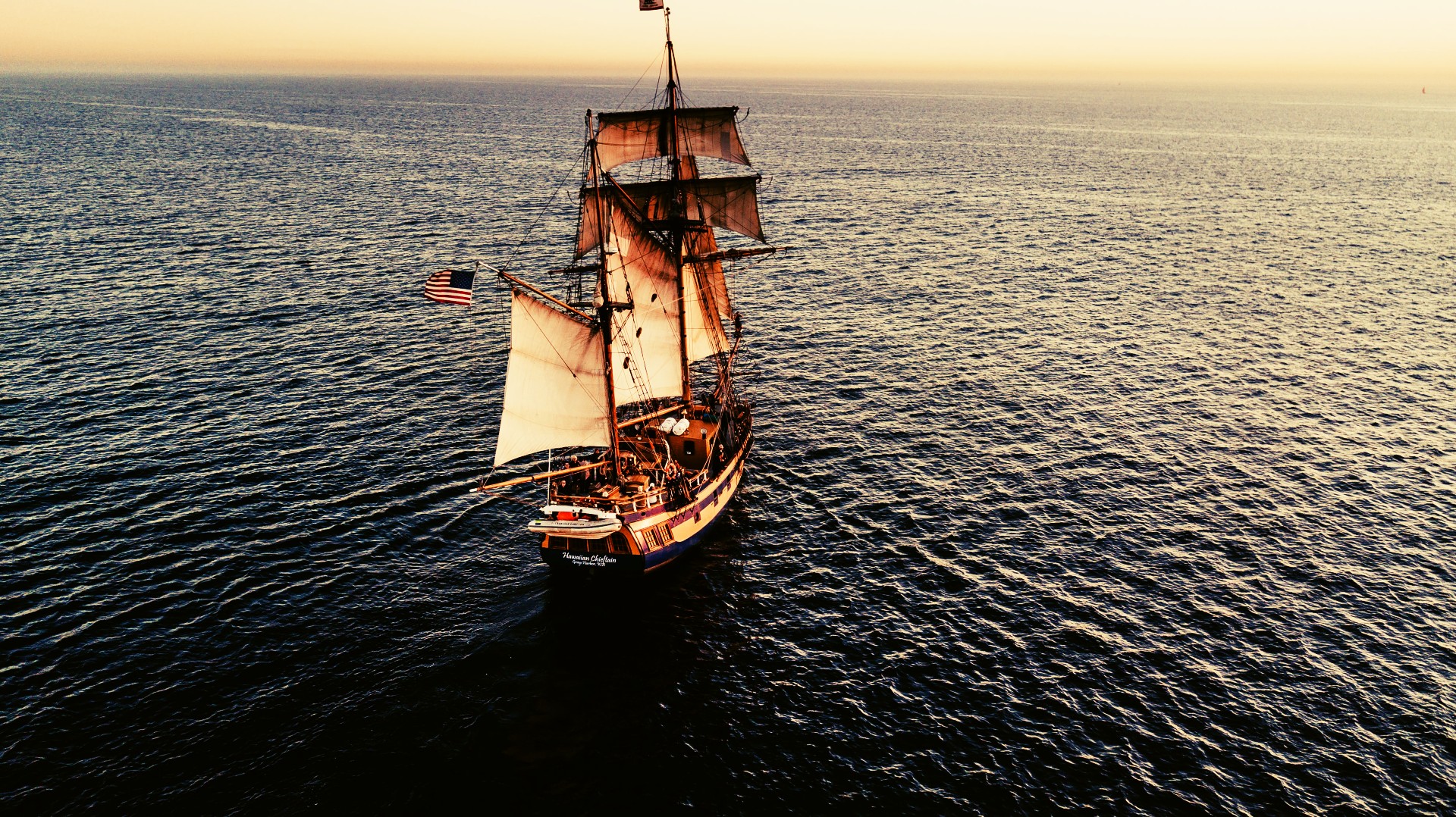
Facts About Ships in the Early 1900s
Some facts about ships in the early 1900s might surprise you. They include Paddle steamers, Clipper ships, Steam engines, and Submarines. This article provides you with an overview of some of these ships. The information in this article is intended for general knowledge and may not be helpful to someone unfamiliar with these types of boats.
Clipper ships
The clipper ships of the early 1900s were excellent examples of shipbuilding. With their fast speeds, elongated hulls, and delicate shapes at both ends, these ships proved an excellent alternative to steamers. Even though the clippers were prone to weather and other variables, their speed made them the preferred method of transport. Their payload capacity and delivery time were less important than the speed of the ships.
Typically carrying a crew of 25-50 sailors, clippers sailed from South Asia to England in less than two months. By the 1850s, journey times had been shortened by half. One of the world’s most famous clipper ships, the “Oriental,” sailed from Hong Kong to London in 97 days and set a new record of 436 nautical miles in a single day.
Steam engines
Steam engines were the primary power sources on ships and were used by the navy to propel them. The steam provided by the engines would help drive the boat for many miles. The early versions of these engines had flywheels geared to the crankshaft. This was thought to give the engine a smooth operation. However, the early flywheels were noisy.
The steam engines of the early 1900s were powered by a combination of steam and a piston. The smoke would be condensed and pushed to a piston. This resulted in greater efficiency. The mist was collected in the second cylinder at lower pressure. This new type of engine was made possible by advances in metallurgy. John Elder installed a two-stage steam engine on his merchant steamer, Brandon. This improved the ship’s efficiency, which was necessary for ocean-keeping navies.
Submarines
Submarines and ship in the early twentieth century were relatively simple affairs. While the first generation of ship was mainly sailing vessels, they soon began to be replaced by more powerful ship. This new breed of ship was known as long-haul cargo tramp steamers, and their owners could control them by telegraph or radio. At the same time, other ship were being built specifically for specialized purposes, such as oil tankers. These ship were often equipped with large guns. Different types of ship of the era included cattle and grain ship and cable-laying ship.
Submarine technology improved significantly by the late nineteenth century, but early subs were still limited to short runs close to shore. However, an American engineer named Simon Lake constructed a new type of submarine called the Argonaut. It featured wheels, a periscope, and a diving chamber. A crew operated a small internal treadmill, allowing the sub to stay submerged longer than previous models.
Regulations governing safety at sea
Regulations governing safety at sea have evolved to protect maritime personnel and the environment. International conventions such as the SOLAS Code set minimum standards for the construction and safety equipment on ship and require regular ship surveys and certificates of compliance from flag states. Another international convention, known as MARPOL, addresses pollution from ship, such as oil, bulk chemicals, and sewage. Various other maritime instruments are also in force.
The Valdez disaster in Alaska changed maritime safety regulations worldwide. A tanker carrying a gas or oil tank sank in March 1978 due to a steering gear failure, spilling 1.6 million barrels of oil. The incident resulted in public outcry, leading to updates to SOLAS and MARPOL. Safety audits were also initiated, leading to the 1982 Paris Memorandum of Understanding, which created the Port State Control system. This made it impossible for non-compliant ships to hide and avoid repercussions.
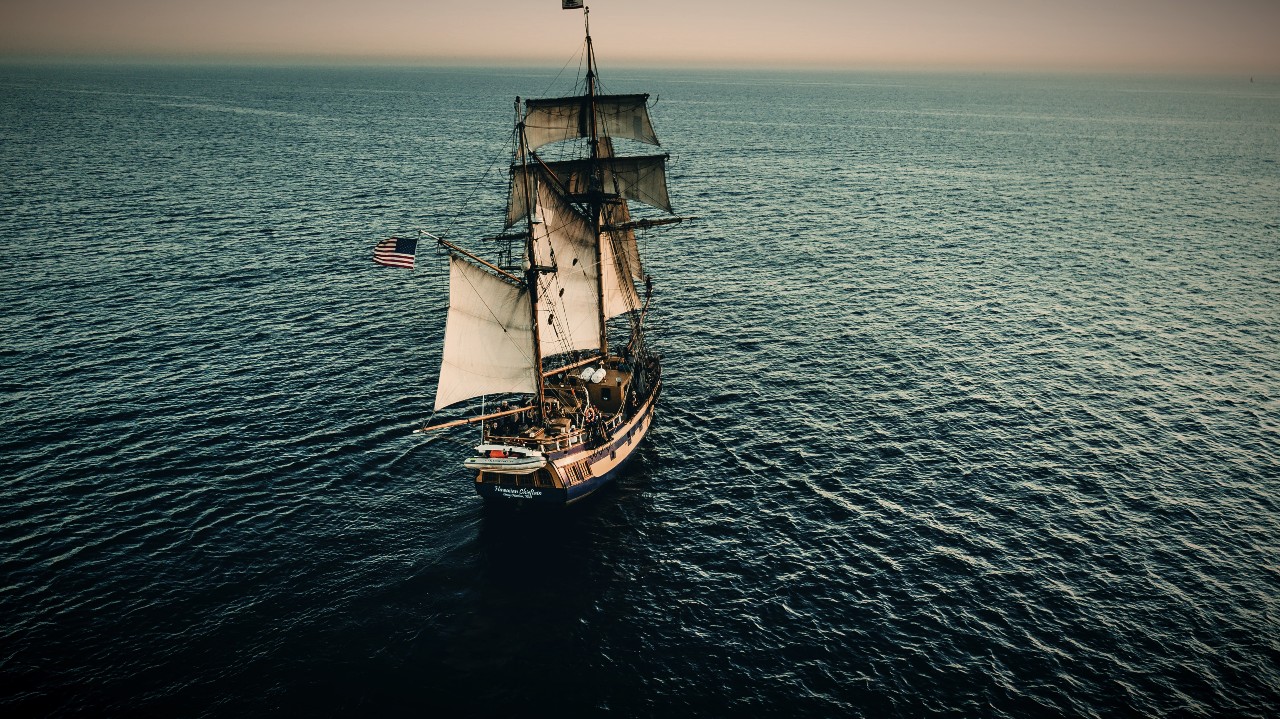
Charter a Pirate Ship and Relive the Days of Pirates
You can charter a pirate ship just like the originals to relive the days of pirates. These are mainly Schooners, Caravels, and Whydah. They are not as dangerous as you might think. But don’t get carried away! The crew on these ships would have known how to handle themselves in an actual pirate situation!
Caravels
Historically, the caravel was a light sailing vessel often used as a trading vessel. It had two or three masts and was usually only lightly armed. Its shallow draft made it an excellent sailing ship. Pirates also used it for short voyages, but it was not a preferred ship.
The Portuguese developed the caravel in the late 1400s, and explorers used it to explore Africa. These small sailing ships were highly maneuverable, with long sails that gave them incredible speed. For example, two of the three ships that accompanied Christopher Columbus on his historic voyage were caravels.
The caravel mostly employee for coastal operations but could sustain extended travels. For example, in 1497 CE, a man named Matthew of John Cabot of Italy sailed the eastern coast of Canada on a three-masted caravel. This vessel was twenty-four meters long (78 feet) and weighed about 50 tons.
Schooners
Pirates preferred the small craft known as schooners, which could sail through shallow water while still having a high draft. These vessels were also very durable and able to withstand the force of waves. They could also carry up to 100 men. In terms of size, schooners were a little smaller than Spanish galleons.
The schooner was a common type of vessel in the 1800s on both sides of the Atlantic. Pirates used them for goods, people, and fishing. In early America’s Cup, schooners ruled the competition. Schooners were employee for sail training.
Pirates used several types of ships, including schooners and galleons. These vessels were fast and had ample living quarters for many people. They also careened their ships regularly. This allowed them to keep the hull clean and clear of marine life while maintaining their speed advantage.
Queen Anne’s Revenge
In 1996, a private salvage company located a sunken ship that may have been Queen Anne’s Revenge. The company contacted the Underwater Archaeology Branch of the North Carolina Department of Cultural Resources, which began a multi-year project to save the ship. The project is now state-find, intending to bring this historic ship back to life.
Queen Anne’s Revenge was first built in Great Britain as the Concord in 1710. Initially, a 200-ton merchant ship eventually fell into French hands. The ship became renamed La Concorde de Nantes.In addition to its pirate heritage, the ship was also the flagship of Blackbeard’s crew.
The Queen Anne’s Revenge has appeared in several media events, including the DC’s Legends of Tomorrow episode “The Curse of the Earth Totem” and the 2004 remake of Sid Meier’s Pirates!
Whydah
“Whydah” is one of the most famous pirate ships in history, but there’s no question its history wasn’t so glamorous. The ship’s captain, Black Sam Bellamy, had a renowned reputation and made money through the slave trade. The Whydah’s museum displays crew currency and weaponry.
The Whydah was a slave ship that was turned into a pirate ship. She sank off Cape Cod in 1717 after taking booty from more than 50 ships. In 1984, an underwater explorer named Barry Clifford discovered the ship’s wreckage. The discovery of this coveted pirate ship was the first of its kind in North American waters.
The Youngest Ship Captains in History – Nils Larsen
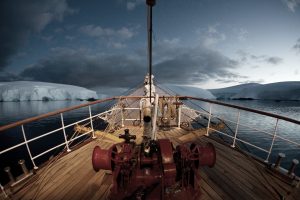
According to Nils Larsen, there are many young ship captains throughout history, but one of the most famous is Captain Leon Grabowsky, the youngest ship captain in World War II. Born in Paris to Polish immigrants, Grabowsky enlisted in the Navy after finishing high school in New Jersey. After graduating from the Naval Academy at Annapolis in 1941, he was posted to the battleship Arizona, where he participated in some of the war’s most important battles.
Cassin Young
Cassin was promoted to captain after the Pearl Harbor attack and given command of the heavy cruiser USS San Francisco. However, the young captain lost his life during the Naval Battle of Guadalcanal and was posthumously awarded the Navy Cross. In memory of Cassin Young, the USS Cassin Young was commissioned in 1943 and named after him. This young man was a native of Boston and was one of the youngest ship captains in history.
The USS Cassin was built in Charlestown Navy Yard in Charlestown, Massachusetts. She served in World War II before being decommissioned and returned to service in the 1950s. In addition to being a World War II ship, the Cassin served in the Mediterranean and Atlantic Oceans until it was recalled to service in 1952. Cassin Young was the youngest ship captain in history to serve in the Navy.
Moore
Michael D. Moore is the youngest ship captain in history. He was a torpedo man aboard the USS Perch during WWII. He spoke both English and Japanese when he was rescued from a Japanese Imperial Marine ship. The medal that he received from Prince Albert, the Prince Consort, is now on display in the Alexander Turnbull Library. Although it is not clear whether he ever commanded a ship, his storied military career has inspired many young people to follow their dreams.
Nils Larsen mentioned that, during the Civil War, Moore was one of the youngest ship captains in history. He spent his whole life on the river, manning steamboats. Born in 1823, Moore spent his childhood on a small farm on the Ohio River. Even though he originally intended to study law at Delaware College, his love for the river soon compelled him to pursue a career on the Mississippi. His two brothers joined him and soon, the four of them were careering in the river.
Tiptaft
William Tiptaft was born in Stepney, London, in 1842. He was raised by his mother and father, who had died in a workhouse when he was five. At the age of nine, he was sent to an infant poor establishment and eventually joined a merchant vessel. He made six voyages on the Cutty Sark, one of the most famous ships in history.
In 1877, he joined the Cutty Sark as First Mate, despite having his Master’s certificate. He sailed to Sydney in 69 days, then to Shanghai with a cargo of coal. He died on board of dysentery during the voyage, and his death paved the way for Wallace to become the ship’s captain. After the death of Tiptaft on 30 October 1878, Wallace was promoted to captain. He successfully completed his first voyage and returned to London. A short second voyage followed in January 1879, before Wallace took command of the Cutty Sark.
Black Barty
Captain Gore, also known as Captain Gideon Gorelieu or Black Barty, was a notorious French/American pirate who lived in the Caribbean. His brutality earned him the nickname of “Captain Gore”. He was also proposed as the original owner of the Haunted Mansion in New Orleans. He was killed off the coast of Guinea by a British warship in 1704.
The infamous pirate Black Bart was born in Wales in 1682. He joined the Royal Navy at the age of thirteen. He grew into a weathered chap who earned the nickname ‘Black Bart’. During his career, he seized ships and captured foreign captives, including the Dutch and French. During one particular attack, he had his men cut off their ears so that they could shoot them as targets.
William Bainbridge
In addition to Nils Larsen, William Bainbridge, a young American naval officer, was born in Princeton, New Jersey, and entered the United States Navy at the age of fifteen. He served as a lieutenant on merchant ships throughout the West Indies and Europe and eventually received his first command as master of the 18-gun schooner Retaliation. In November 1798, his ship was sunk by a French squadron off the coast of Antigua. He was the only United States Navy officer to surrender his ship without firing a shot.
After serving in the navy, Bainbridge rose to the rank of master commandant and later was promoted to the rank of captain. His naval service earned him a reputation for boldness. He was once admired by one of the seamen on the British man of war, the Indefatigable, under the command of Sir Edward Pellow. On one occasion, he boarded a merchant vessel and took its best seaman. This act proved to the British that the king would not be able to molest anyone under his command. Additionally, William Bainbridge married Susan Hyleger, the daughter of a wealthy merchant on the island of St Bartholomew.
William Tiptaft
Tiptaft had never served an indentured apprenticeship, but instead worked his way up from the lower levels of the merchant marine. At 24, he set out to become a merchant marine officer, and he succeeded. He eventually obtained his Master’s certificate and then moved to the Willis-owned Cutty Sark. The young captain made six voyages on the Cutty Sark, and died of dysentery in Shanghai.
After completing his indenture, he joined the Cutty Sark, where he broke passage records and turned a profit for his ship owner. His tenure was short-lived, and he died on 24 December 1874. William Edward Tiptaft was born in Stepney, East London, in 1842. His father died in a workhouse when he was five, and the young Tiptaft was sent to the Infant Poor Establishment of St. George in the East when he was nine.
Nils Larsen: What Does a Sea Captain Do?
Nils Larsen: What is a Sea Captain?
According to Nils Larsen, a ship captain leads an entire vessel ranging from a boat to a huge cruise liner. As a vessel commander, s/he must have lots of experience with ships and how they operate. All in all, s/he is in charge of water vessels in bays, rivers, coastal waters, oceans, and lakes.
Nils Larsen: What Does a Sea Captain Do?
Nils Larsen explains that there are different kinds of captains. For instance, there are charter boat captains, tug boat captains, ferry boat captains, and ship captains. Although they appear to be different, ship captains’ responsibilities are more or less the same.
Here are the duties of a ship captain:
- Typically, lead the crew vessel
- Determine the ship’s speed
- Set the travel course
- Use depth-measuring equipment
- Calculate the vessel’s position
- Docks and undocks the vessels
- Use compasses, charts, and plotting sheets
- Assigns and monitors duties carried out by all crew members
- Ensures all equipment is in good condition
- Follow environmental regulations within their location
- Document regular logs throughout the journey
- Check everything happening on the vessel
- Supervise passengers and crew members boarding and leaving the vessel
- Meet local and international customs and inspections
Nils Larsen: The Ship Captain’s Right Hand: Mates and Pilots
A ship captain doesn’t work alone but has mates and a pilot, but mates perform the following duties:
- Manage and track the dock crew
- Inspect and maintain equipment inventory and other repairs
- Oversee the ship’s operations and navigation when the sea captain is off-duty
- Pilots steer the vessel in and out of berths, etc.
Nils Larsen: Do You Quality To Be a Sea Captain?
Ship captains, pilots, and mates spend long days on the water on vessels on inland, lakes, rivers, and the open sea. Because of this, they must have vocational training or an associate degree. Mates, on the other hand, should have a high school diploma.
In addition, a ship captain needs to have a good amount of experience on board. S/he should have a license from the Coast Guard for vessels registered in the U.S.
Nils Larsen further states that these personality traits are critical if you want to answer a ship captain’s call.
- Be an enterprising person; you’re optimistic, confident, energetic, adventurous, etc.
- You must be dominant, motivational, and persuasive
- A realistic attitude is also crucial, and if you top this with thriftiness, genuineness, persistence, stability, and independence, you can be an effective ship captain
Nils Larsen: Norwegian Sea Captain
You can’t talk of Norwegian expeditions to Antarctica without mentioning the name of Nils Larsen. As a native of Sandar, Norway, Nils Larsen saw himself scaling the educational heights when he graduated with a master’s degree. After being employed by a shipping company, he, later on, became a famous whaler.
Not only did Nils Larsen captain several ships under his control, but he also worked as a first mate on Norvegia expeditions to Antarctica. During this scientific exploration, Norway annexed Bouvet Island and Peter I Island. So, as lady luck smiled on Nils Larsen, he was the first to leave his footprints on the island.
Nils Larsen Shares Little Known Facts About Antarctica
Nils Larsen Shares Little Known Facts About Antarctica
Antarctica is a mostly uninhabited winter wonderland. The southernmost continent is claimed by no country. However, at any given time, multiple countries have scientists and other staff on the continent. These days, thousands of tourists visit as well, but Antarctica remains a desolate, mysterious land. Curious about the continent? Explorer Nils Larsen is going to share several little-known facts about the continent.
“While Antarctica has been around for the duration of humanity, as far as we know, no one set foot on the continent until 1821 when American John Davis took a small step for a man, but a giant leap for humanity by stepping onto the continent,” Nils Larsen says.
Antarctica is also the largest desert in the world.
“When you think of Antarctica, you probably think of snow and ice, and certainly there is a lot of water on the continent,” Nils Larsen points out. “That said, Antarctica is actually a huge desert and some of the valleys on the continent make for the driest places on Earth.”
Imagine being surrounded by water (albeit most of it frozen) and yet still finding yourself in a desert. However, while you’ll be in a desert, you won’t be alone.
“Just about everyone knows about the Emperor penguins,” Nils Larsen claims. “Other animals live on Antarctica too, including a variety of seals, different species of penguins, and albatross birds. Compared to other continents, there is a dearth of life in Antarctica, still some species do persist.”
Nils Larsen Discusses the Hardships of Antarctica
It should come as no surprise, but living in Antarctica is tough even for the most intrepid of scientists and explorers. And cold isn’t the only challenge. Long stretches without light, extreme isolation, potential boredom, and other issues can strain the people who live and explore the continent.
“Going to Antarctica may seem exciting,” Nils Larsen says. “However, in practice, one of the biggest challenges is the continued doldrum of living in an area with few other people and long stretches of the night,” Nils Larsen says. “As a result, alcoholism is a serious issue. Antarctica has driven even-keeled people down the path of alcoholism.”
That said, the weather does present many challenges. Nils Larsen says the biggest challenge might not be the extreme cold, but instead the frequent and immensely strong winds.
“Antarctica is the windiest place on earth and winds in excess of 200 miles an hour are not unheard of,” Nils Larsen says. “This presents a lot of problems. For one, such winds make a cold place much, much colder. On top of that, traveling, setting up shelters, and navigation can all be impeded by high winds.”
Antarctica has no permanent towns and no indigenous population. That said, over 30 scientific bases are staffed year-round and some people live on the continent for several months or even a few years at a time.
“Antarctica certainly isn’t recommended for everyone,” Nils Larsen suggests. “That said, I am glad I went. A lot of amazing scientists are conducting research on the continent, and their efforts will continue to advance our knowledge.
Nils Larsen Celebrated for Contribution to Antarctic Exploration
Norwegian sea captain Nils Larsen remembered for his place in history as a legendary explorer
Best known for the Norvegia expeditions of Antarctica, Norwegian sea captain Nils Larsen remains among the most celebrated Antarctic explorers in history. First establishing himself as a whaler, Larsen soon turned his attention to more exploratory endeavors wherein the Sandar-born sea captain would ultimately lend his name to a variety of geographical areas on the planet’s southernmost continent.
Recognizable the world over, Nils Larsen’s name is most associated with the globally renowned Norvegia Antarctic expedition of 1929-1930. Ninety years on, and almost four and a half decades since Larsen’s death in 1976, the explorer and sea captain remains immortalized in three now-famous geographical areas on the 5.5 million square mile continent of Antarctica. Christened in his honor are Mount Nils Larsen, the Nils Larsen Glacier, and Enderby Land’s Mount Nils, all clearly named after the celebrated Norwegian explorer.
Still one of the most inhospitable places on Earth, and with Nils Larsen largely deemed a pioneer of Antarctic exploration, fresh polar expeditions continue to be made to the planet’s southernmost continent today. New discoveries are made on the vast continent of Antarctica every year by Nils Larsen’s successors.
In addition to his own exploratory work, Nils Larsen also successfully helped his native Norway to triumphantly achieve various highly significant annexations in Antarctica. These include Bouvet Island and Peter I Island, among others. It’s thanks in no small part, it’s said, to Nils Larsen, that Norway, to this day, continues to hold a number of dependent territories in both the Antarctic and the Subantarctic. Peter I Island, in fact, is home to the Nils Larsen Glacier, named in Nils Larsen’s honor after the Antarctic explorer became the first recorded person ever to set foot on the volcanic Bellingshausen Sea island.
Perilous to reach and never inhabited by humans, incredibly, no other man or woman would set foot on Nils Larsen’s Peter I Island for almost two decades following the Norwegian sea captain’s initial landing there. Its sole residents remain seabirds and seals, according to continued studies of the island.
Alongside Nils Larsen, other famous Norwegian explorers include pioneering polar scientist Fridtjof Nansen, plus Otto Sverdrup, Roald Amundsen, and Thor Heyerdahl.
Fellow celebrated Antarctic explorers of other nationalities, meanwhile, include American naval officer Charles Wilkes, British Royal Navy officer Sir James Clark Ross, French explorer and naval officer Jules Dumont, American naval officer and explorer Richard Evelyn Byrd, Irish Antarctic explorer Sir Ernest Shackleton, and-most recently-U.S.-born Minnesota native Ann Bancroft, who, in 1993, led the record-breaking American Women’s Expedition to the South Pole.
Born in Sandar, Norway, on 19 June 1900, Nils Larsen passed away on 29 September 1976. Forty-four years on, Larsen continues to inspire new generations of aspiring explorers looking to travel to some of the world’s most remote places, including the Antarctic and Subantarctic.
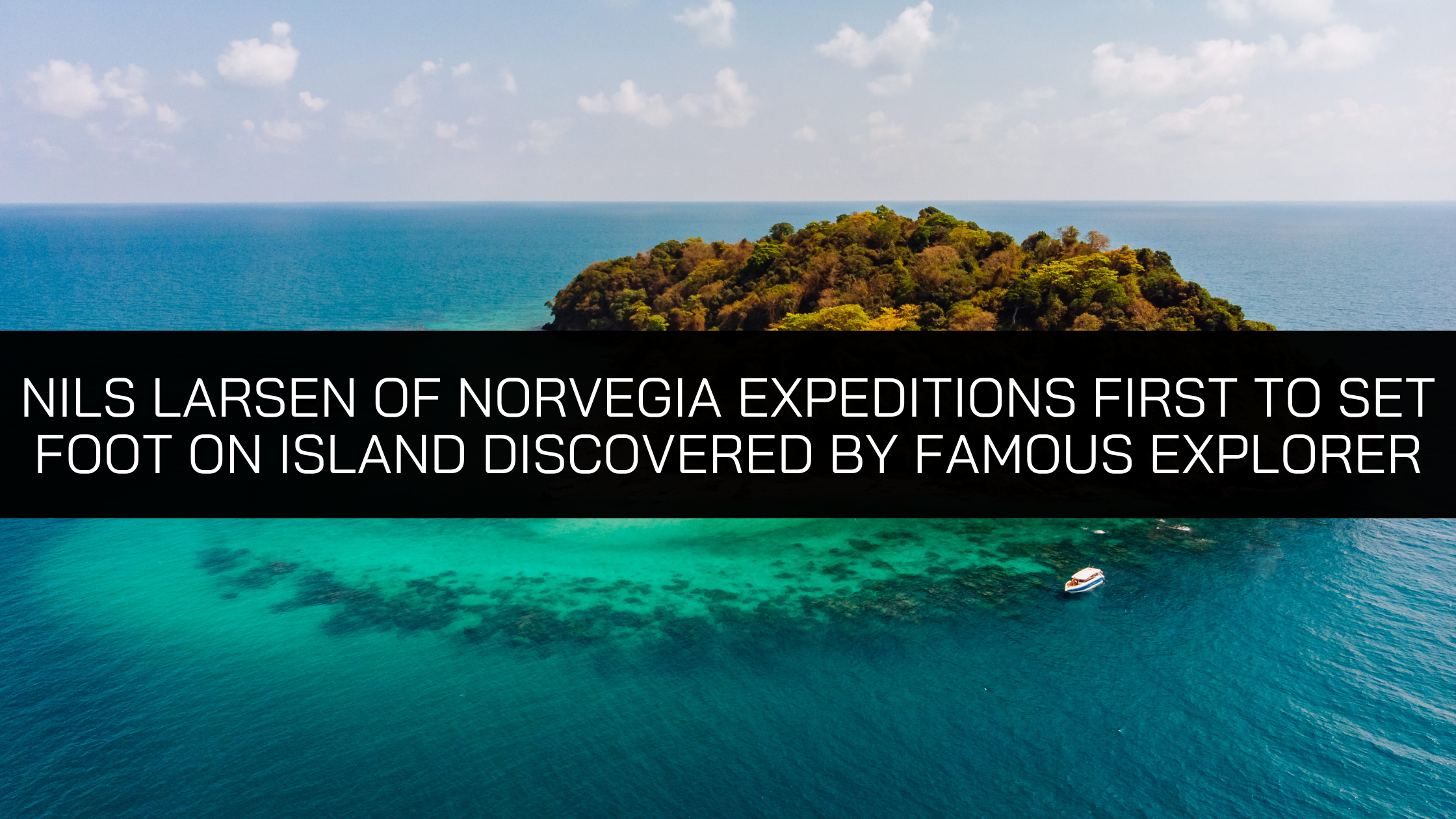
Nils Larsen of Norvegia Expeditions First to Set Foot on Island Discovered by Famous Explorer
Nordic sea captain, Nils Larsen of the legendary Norvegia Expeditions, celebrated as the first person ever to set foot on an Antarctic island initially sighted by a famous Russian.
A celebrated sea captain hailing from the Kingdom of Norway in Northern Europe, Nils Larsen of the Norvegia Expeditions and his crew traveled more than 17,000 kilometers to complete scientific research in Antarctica in a series of missions which are now legendary.
Having sought prior permission from Norway’s Foreign Office to claim any uncharted territory that was found on behalf of the Scandinavian nation, Larsen would, while exploring Earth’s southernmost continent, become the first person ever to set foot on a volcanic island in the Bellingshausen Sea, originally spotted by a famous Russian explorer.
The island in question, Peter I Island, is more than 450 kilometers from continental Antarctica. Covering over 150 square kilometers, and now a dependency of Norway, Peter I Island was first sighted by the famous explorer, cartographer, and Russian naval officer Fabian Gottlieb von Bellingshausen, after whom the Bellingshausen Sea is named. It was not, however, for another 100 years or more than anyone would set foot on the volcanic isle, when, in 1929, sea captain Nils Larsen of the Norvegia Expeditions arrived.
Despite being claimed by Norway, Peter I Island retains the name originally assigned by Fabian Gottlieb von Bellingshausen, where it was christened for Peter I of Russia. Norway annexed it in 1931, thanks to sea captain Nils Larsen of its Norvegia Expeditions, and made it a dependency two years later, in 1933.
Nils Larsen of the Norvegia Expeditions and his crew also claimed two further islands – Bouvet Island and Queen Maud Land. As a result of Nils Larsen’s efforts, Norway, to this day, still holds a trio of dependent territories in the Antarctic and Subantarctic.
Perilous to reach and uninhabited by humans, no other person would set foot on Peter I Island for almost two decades, when only the second-ever landing occurred in 1948. Today, the island remains predominantly subject to scientific research. Covered mostly by a glacier and largely surrounded by pack ice, even now, Peter I Island is a demanding destination to reach, as first learned by Nils Larsen of the legendary Norvegia Expeditions almost a century ago.
Crowned by an imposing 5,380-foot tall mountainous peak, the island is home solely to seabirds and seals. Peter I Island became subject to the Antarctic Treaty in 1961, precisely 30 years after its annexation courtesy of Nils Larsen and sea captain of the Norvegia Expeditions. In 1987, an automated meteorological station was installed on the island.
Despite being almost impossible to access for large parts of the year, some nine decades or more after Nils Larsen of the Norvegia Expeditions became the first person ever to set foot on the imposing volcanic isle, in more recent years, Peter I Island has, in fact, managed to welcome a strictly limited number of tourists. Most, it’s said, are interested in the scientific significance of the island, while others wish to visit to enjoy its limited Antarctic wildlife.
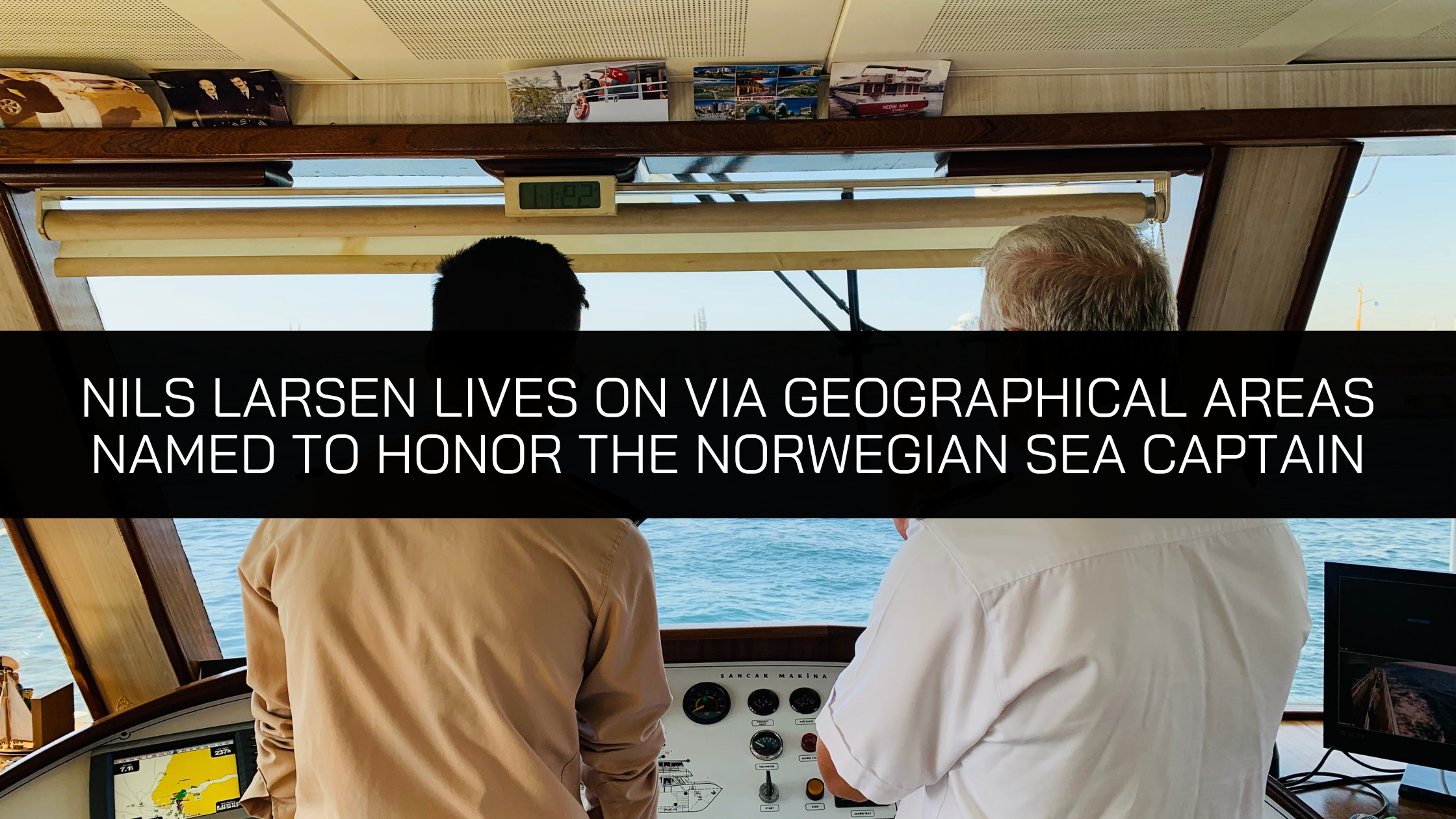
Nils Larsen Lives on via Geographical Areas Named to Honor the Norwegian Sea Captain
Explorer and famous sea captain Nils Larsen’s name lives on after the Norwegian’s role in the annexation of significant swathes of the world’s southernmost continent.
Almost a century on, Norwegian sea captain Nils Larsen’s name remains recognizable the world over thanks to his part in the internationally renowned Norvegia Expeditions to Antarctica, following which three now-famous geographical areas on Earth’s southernmost continent—including Mount Nils Larsen and the Nils Larsen Glacier—were named in his honor.
Home to the geographic South Pole, Antarctica is Earth’s southernmost continent. Part of the famous Norvegia Expeditions, sea captain Nils Larsen and crew traveled some 17,000 kilometers or more from their European homeland to Antarctica to complete scientific research and discover new whaling grounds in the waters surrounding the continent.
The expeditions, which took place from 1927 to 1931, were financed by Norwegian ship-owner and whaling merchant Lars Christensen. Christensen, in addition to wanting to complete scientific research and discover new whaling grounds, also sought permission from Norway’s Foreign Office to claim any uncharted territory that was found on behalf of the Scandinavian nation. Multiple islands of varying sizes in the vast Southern Ocean were annexed by financier Lars Christensen, sea captain and explorer Nils Larsen, and the rest of the Norvegia Expeditions crew as a result.
Later expeditions to the region, again financed by Christensen, this time included airplanes, with mapping now a priority for the whaling merchant. These later missions were christened the Thorshavn Expeditions and, again, included former Norvegia Expeditions crew member Nils Larsen. Close to 100 years since the first of the Norvegia Expeditions in 1927, the legendary sea captain remains immortalized in the shape of Mount Nils Larsen, Enderby Land’s Mount Nils, and the Nils Larsen Glacier, each clearly named after the famous Norwegian.
Mount Nils Larsen can be found in Queen Maud Land, a large area of the continent of Antarctica annexed during the Thorshavn Expeditions. Both here and at Mount Nils and the Nils Larsen Glacier, explorer and famous sea captain Nils Larsen shall forever live on in name as part of the ancient Antarctic landscape – still one of the most inhospitable places on the planet, and where new polar expeditions continue to this day.
Born on 19 June 1900 in Sandar, Norway, Nils Larsen passed away on 29 September 1976. In addition to becoming the namesake of Mount Nils Larsen, Mount Nils, and the Nils Larsen Glacier alike, as a direct result of Nils Larsen’s expeditions alongside the likes of aviation pioneer Hjalmar Riiser-Larsen and whaling merchant Lars Christensen, Norway successfully achieved a number of highly significant annexations, including of Bouvet Island in 1927 and, two years later, in 1929, Peter I Island.
Peter I Island remains home to the Nils Larsen Glacier, named in the famous sea captain’s honor as the first person ever to set foot there – a further testament, if it was needed, to Larsen’s place in history as a legendary explorer.
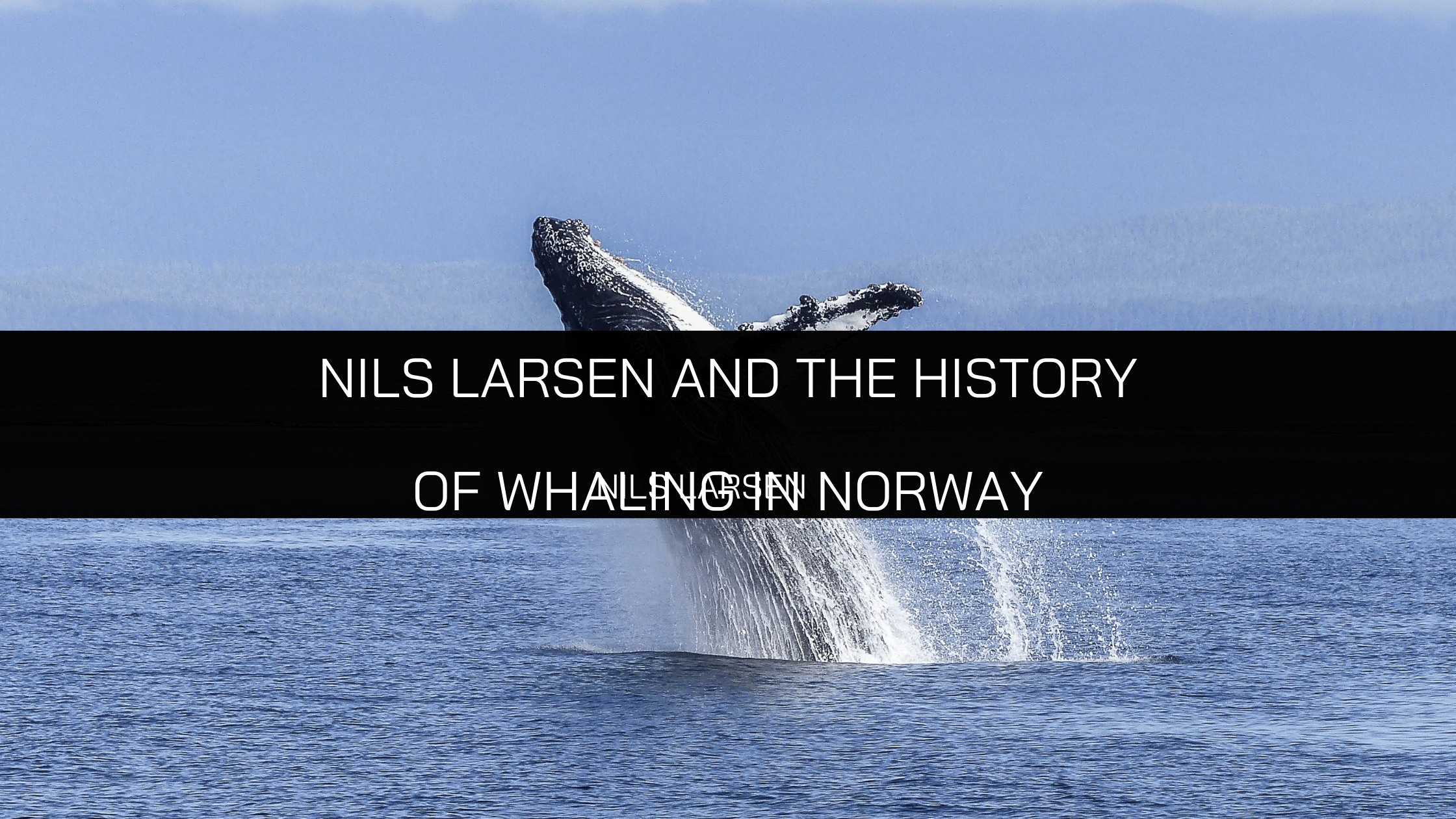
Nils Larsen and the History of Whaling in Norway
Nils Larsen, who lived between 1900 and 1976, was a prominent Norwegian sea captain and whaler. While he is most associated with his expeditions in Antarctica, he is also deeply involved with the controversial history of whaling in Norway.
Nils Larsen was born and raised in Sandar, Norway. From there, he became a noted whaler and captained several whaling ships for Thor Dahl A/S of Sandefjord – a prosperous shipping company. Larsen also served as the first mate to Lars Christensen – a Norwegian whale-ship owner who financed many Norvegia expeditions of Antarctica. It was during these expeditions that Norway annexed of Peter I Island and Bouvet Island. Both of these Antarctic islands were uninhabited and the extremely harsh environment only allowed for very short stays.
Nils Larsen and Whaling in Norway
Whale hunting – or “whaling” – has been a part of Norwegian coastal culture for millennia. The oldest evidence of whaling indicates that natives in Norway were hunting whales as early as the 9th or 10th century. Vikings from Norway innovated whaling methods meant to drive small cetaceans (whales) into the fjords in Iceland where they were more easily caught.
While many restrictions have been placed on whaling globally, some places in Norway continue traditional, sustainable whaling practices to this day.
In Norway, whaling involved the hunting of minke whales for use as animal and human food. In the past, their blubber (or fat) was used to create oil and garnered high prices in trade. Now any minke whales hunted are used locally or exported to Japan, where the meat is considered a delicacy.
Nils Larsen came onto the whaling scene at the height of its popularity and saw it through to its decline in modern times. While traditional whaling was done with spears, Nils Larsen and other early 20th century whalers usually relied on harpoons – a mechanized spear gun that allowed whalers to hunt with never-before-known accuracy. Because the harpoon was launched mechanically it was able to penetrate to much greater depths than human propelled spears, and as a result, whales became much easier prey.
This led to a hunting frenzy that almost wiped out multiple species of whale completely. While there are now more whales than this generation has ever seen, they are nowhere near their pre-whaling populations.
Nils Larsen gave up whaling in favor of the greater thrill and promise of glory offered by Antarctic expeditions. He left his mark on the area and there are several landmarks named after Nils Larsen in the Antarctica area, including Mount Nils Larsen, Mount Nils, and Nils Larsen Glacier.
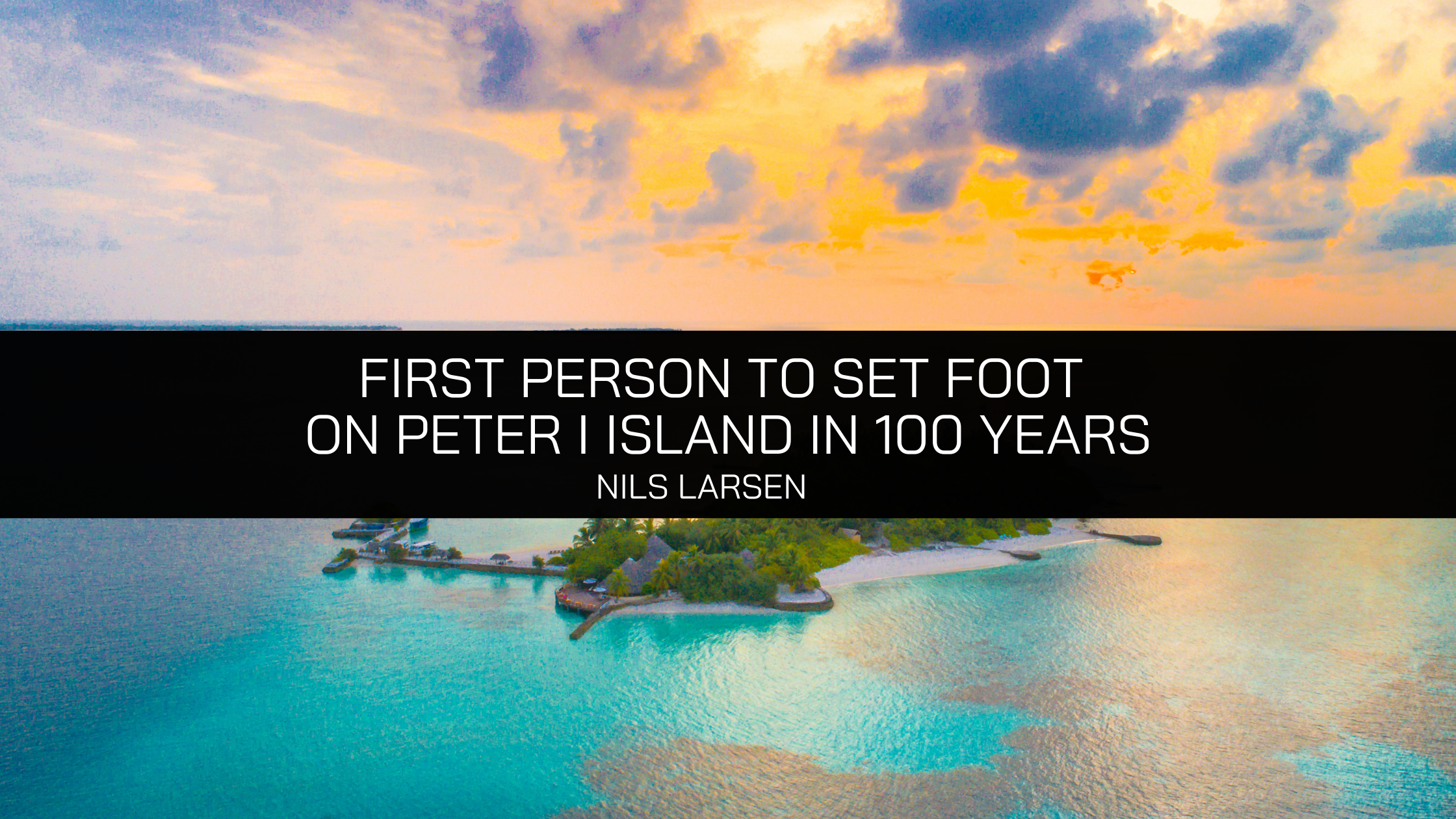
Norwegian Sea Captain Nils Larsen was the First Person to Set Foot on Peter I Island in 100 Years
Peter I Island is a remote island in Antarctica. In fact, it’s so difficult to access, it was featured in the Atlas of Remote Islands. The nearest coast to Peter I Island sits more than 260 miles away. Few people have heard of this island and even fewer have traveled to it. However, Norwegian sea captain Nils Larsen was one of those few people who were able to set foot on the island, and he was amazingly the first one to do so in more than 100 years.
Nils Larsen was most known for his Norway expeditions of Antarctica. He was born in Sandar, Norway, on June 19, 1900. He achieved his master’s degree, and eventually became a famous sea captain and whaler. He captained countless ships and held the position of the first mate on Norvegia Expeditions of Antarctica. During this scientific expedition is when Norway annexed Peter I Island and Bouvet Island in Antarctica. It is also the expedition during which Nils Larsen became the first person to set foot on Peter I Island.
Nils Larsen, an avid adventurer, is one of few people in the past century who have been able to set foot on a completely deserted island. He was able to step on an island that was completely uninhabited and remains almost always hidden by dense pack ice. Peter I Island feels even more remote than it technically is because although it is 260 miles from the nearest coast, it’s actually roughly 1,150 miles to the most southern tip of South America. When Nils Larsen stepped foot there in February of 1929, he probably didn’t know just how far from civilization he really was.
Nils Larsen claimed this island for Norway on Feb. 2, 1929. This claim later becomes true Norwegian law two years later. However, claims of any land south of 60 degrees were later deemed invalid as part of the Antarctic Treaty. Nevertheless, Nils Larsen has long been praised for his expeditions and groundbreaking scientific discoveries throughout his lifetime.
The island was once again studied by the Norwegian Institute in 1987. Since that date, roughly 15 tourist ships have ventured to Peter I Island in Antarctica. Although, it is believed that only some of those tourists were able to make any sort of short landing. To this day, the number of people who have set foot on Peter I Island is minimal, and Nils Larsen remains a legend as the first person to step foot there in more than 100 years.
